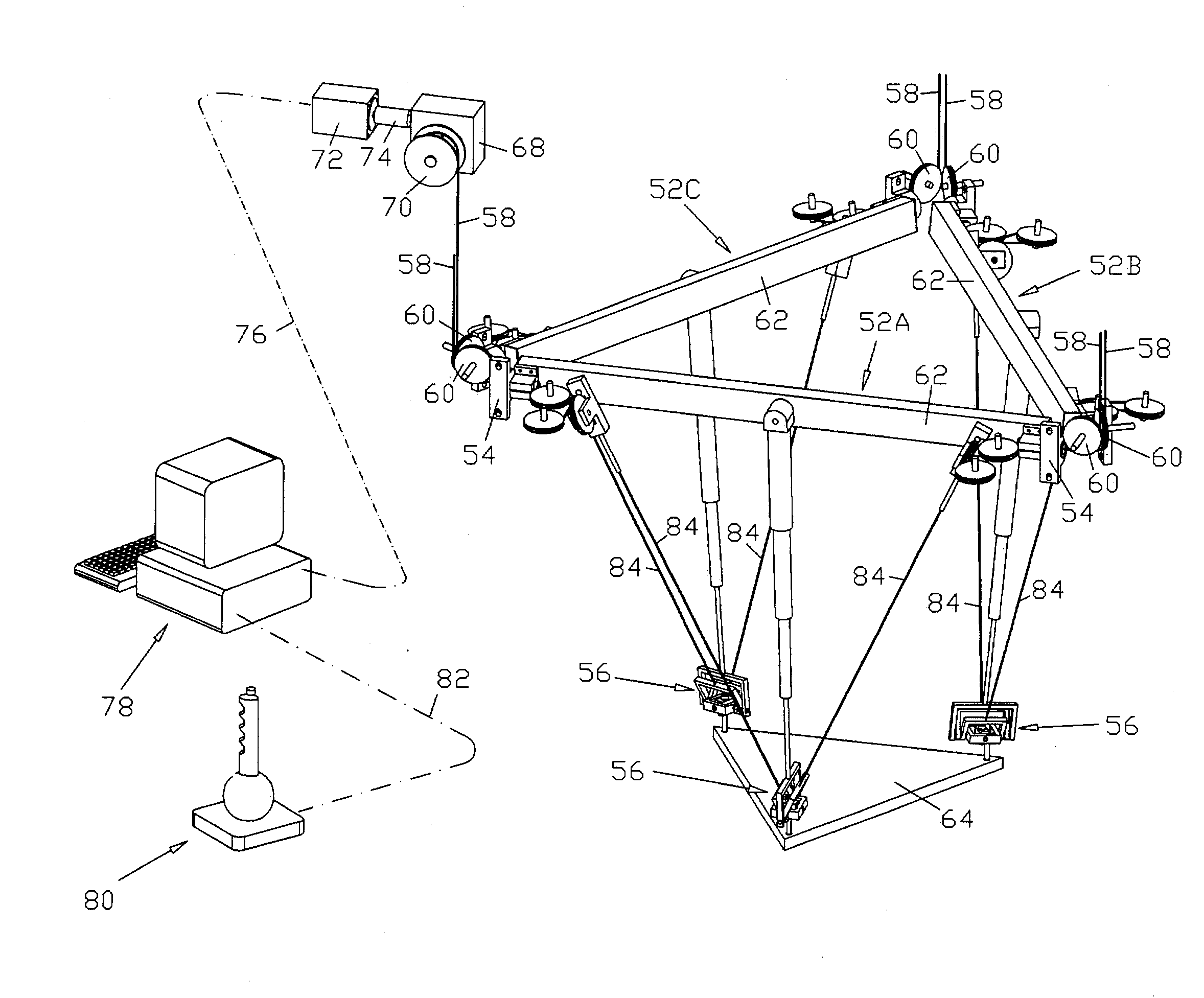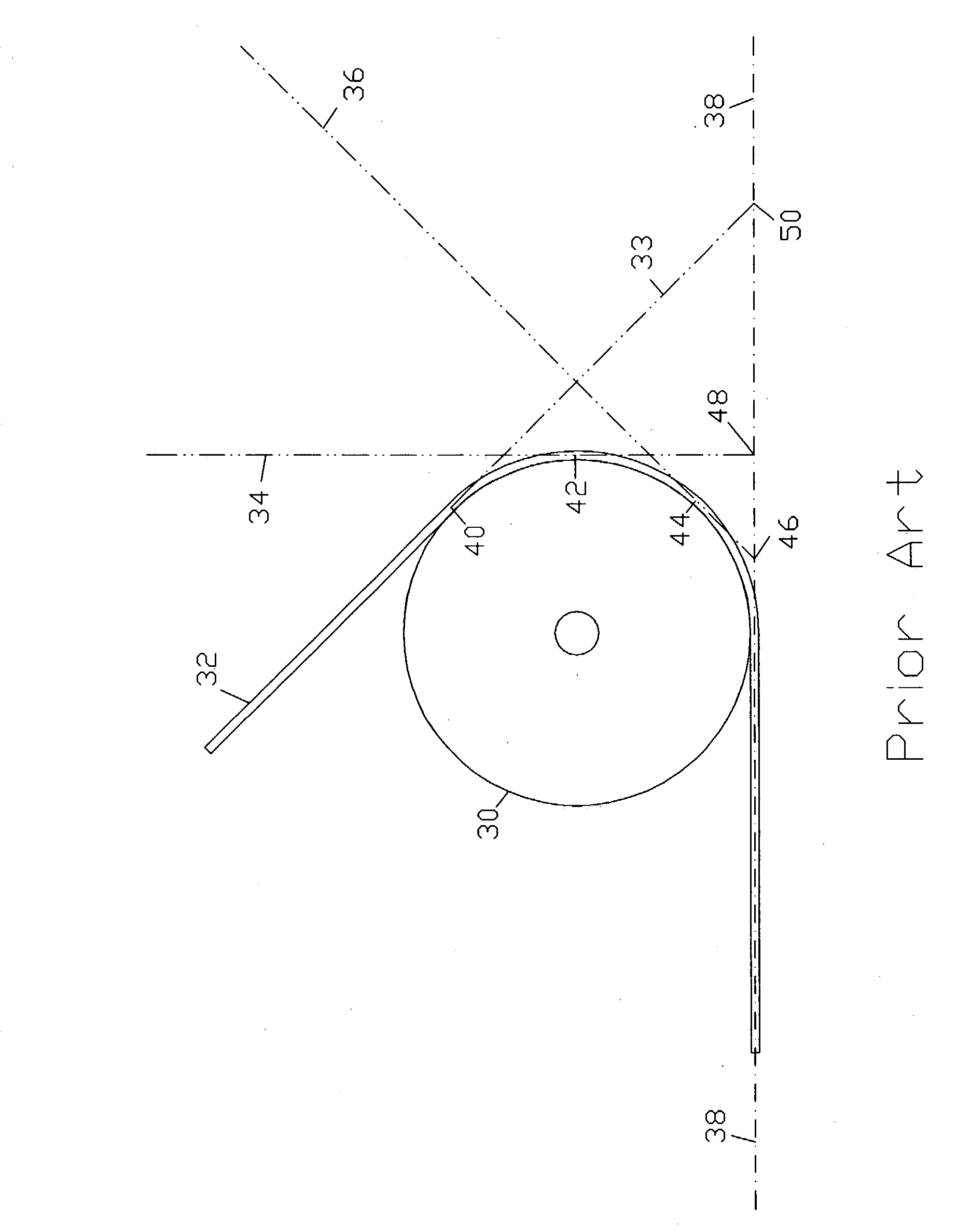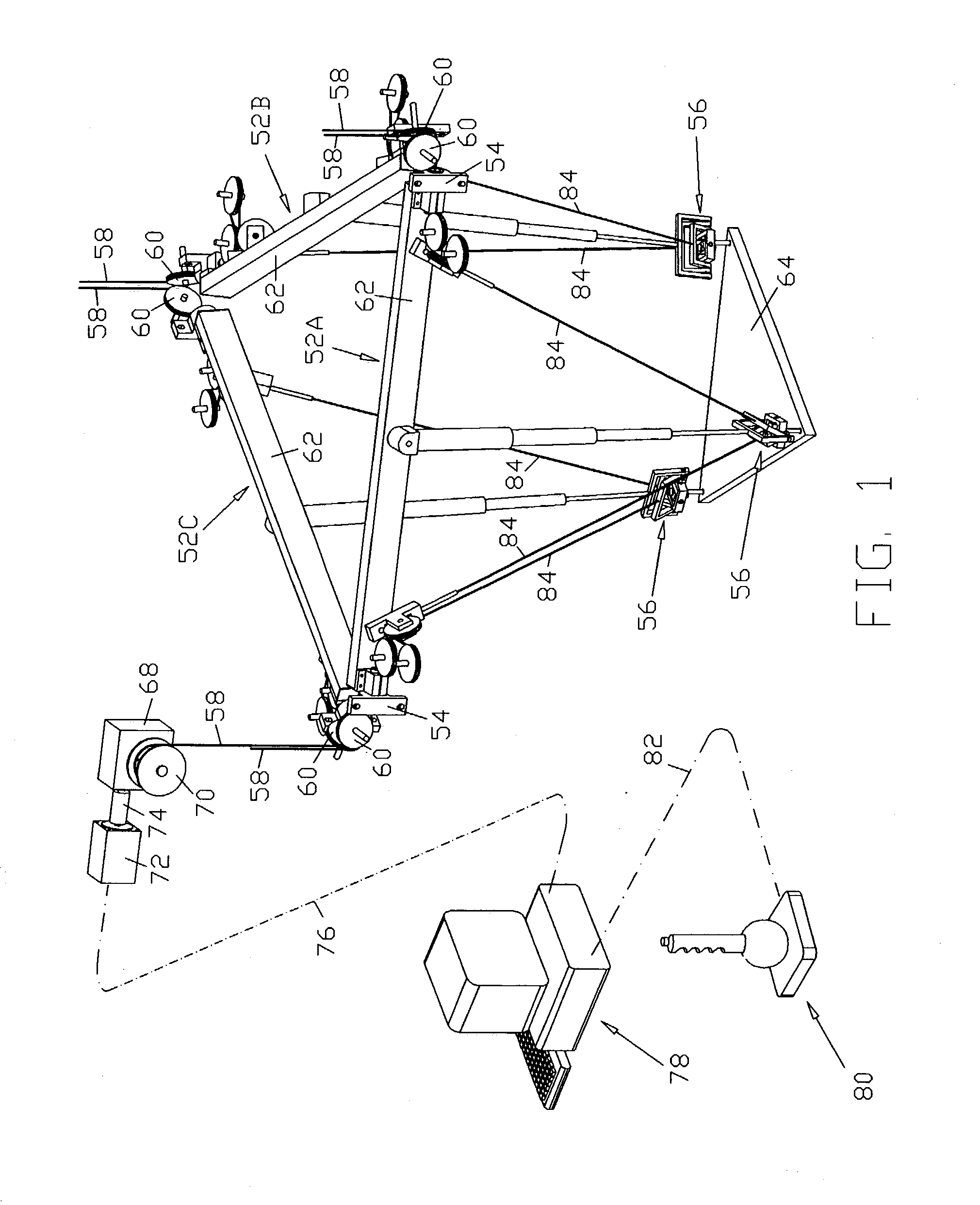However, such serial linkages, cantilevering from the first joint as they do, lack desirable stiffness.
Thus,
repeatability, accuracy, and deflection from the end
effector's desired position, are difficult design considerations.
As stiffness is increased, size and
mass are necessarily increased, and operational speed and cost are adversely affected.
Given the desired end-
effector position, it can be very difficult to determine the optimum joint angles to obtain it.
Forward-kinematical calculations for parallel linkages range from difficult to nearly impossible, for many of the common geometries.
However, the lack of a forward-kinematical solution means that it is more difficult to obtain confirmation that the controlled point is really where the computer calculates it to be.
As a result, position feedback often requires complicated techniques and instruments.
The above disclosed art, while valuable and workable, has the following disadvantages and limitations:
(a) These parallel-link mechanisms have smaller work spaces than serial linkages of the same size.
Work space is limited by so-called singularities (moving-platform positions where the leg vectors create a mathematically-indeterminate
system because of linear dependencies), and by positions where two or more legs interfere with each other. It will be obvious to those skilled in the art that as the diameters of the individual legs increase, the leg-conflict space increases, thereby reducing the available
work space.
Conversely, actuators used as legs significantly reduce the available
work space.
Actuators used as legs additionally require hydraulic hoses for cylinders, motors and power feeds for screws, etc. which can, and often do,
clutter potential work space, thereby further decreasing the available work space, and undesirably increasing the moving
mass.
(b) The above disclosed parallel-mechanism designs, with actuators used for the legs, are not readily scalable.
For example, while a thirty-six inch
hydraulic cylinder is very practical and is widely available, a thirty foot
hydraulic cylinder is not practical for a six-legged-mechanism design, and is not readily available.
Likewise,
hydraulic cylinder legs are not practical for a parallel mechanism, with average leg lengths of a quarter inch.
Ball screws and other commonly available actuators, likewise, are not practical for small and large scale designs.
This range of actuation is too limiting for some applications.
It is obvious that any limitation of the one dimensional actuation range will result in a correspondingly greater limitation of the three-dimensional work space.
(d) As
actuator legs approach their maximum extension, internal tolerances, unbalanced-force-induced bending, and compression-induced buckling can combine to reduce the
effective stiffness and accuracy of the mechanism.
Also, for example, manufacturing tolerances in ball screws can result in cumulative errors for long traverses of the "nut".
(e) Backlash is an unfortunate reality when actuators, as described above, change back and forth between compression and tension loading.
Ball screws and gearing have a certain amount of backlash inherently built in due to manufacturing tolerances.
Usage causes wear, and wear causes increased backlash.
Hydraulic systems can manifest sponginess due to air in the operating fluid, and a form of backlash due to the
hysteresis of fluid circuit components.
Because actuators must be stiff to
resist bending and buckling, such collisions of actuators can easily jam the mechanism, likely with damage to the actuators.
If the actuators are position or motion driven, as opposed to force driven, an unexpected collision can generate high forces, limited only by the capacities of the actuators, which necessarily are considerable.
The potential for high forces caused by
unexpected events is a danger for personnel and equipment.
A further related danger is that of a person being struck and held, or "pinned", by a moving member.
The disclosed mechanisms do not provide means for quickly releasing a person so held.
Such a feedback
system would be bulky, costly, and fragile.
As disclosed, the feedback
system would significantly decrease the available work space described in (a) above because of arm collisions.
Such a solution would be difficult to obtain for real-
time control, for the disclosed geometry.
Prior art does not provide for an economical, robust, and non-intrusive position-feedback method or device for these parallel linkages.
Precision hemispheres and precision spherical sockets are very expensive to make and are subject to contaminant wear since bearing surfaces are operationally exposed to
contamination.
This amount of separation would be unacceptable for some applications due to the kinematical consequences.
Additionally, the ball and socket arrangement places a restrictive total
solid-angle limit because the joint must be designed to withstand tensile loads, as well as the more easily accommodated compressive loads.
Prior art has not provided an economical means of providing pivoting freedom for two leg ends terminating at the same point, without imposing restrictions on the otherwise available work space.
Conversely, by the same requirement, if either end position of any leg is unknowable, then the leg is undefined, and a controller cannot drive the mechanism to a desired point.
An important issue here is that an element of a mechanism may be physically capable of being in a given position and orientation, but not be capable of being driven to that position and orientation with real-time
computer control.
One has only three controllable cables, and obviously no element of the mechanism is capable of movement with
six degrees of freedom.
A
human operator could certainly control the valves with such an arrangement, but could not reasonably predict the resulting motion.
Inverse-kinematical solutions are not possible for all six-legged parallel linkages, but when they are possible they require a lot of computational power, because the interrelationships are complex.
Thus, the claimed
motion control cannot be obtained by direct joy stick (or equivalent) control of the valves.
The six legs move in a synergistically and very unpredictable manner as the platform moves, thereby changing the parallel mechanism's base geometry moment by moment.
Thus, a real-time inverse-kinematical solution is precluded, and the claimed
controllability of the linkage is not achievable.
Thus, the tangent point is unsatisfactory as a defined leg-termination point.
However, even though one degree of uncertainty per leg may be better than two degrees of uncertainty, it is still one degree too much.
Movement of the platform causes the base ends of the legs to move unpredictably, and thus to be unknown.
Further compounding the problem is the fact that although each of the six legs has one degree of uncertainty at its base end, the
direction vector of that line of uncertainty is different for each of six legs.
The problem is compounded by the fact that each link is influenced by every other link, thereby creating an extremely complex effect that is unpredictable.
 Login to View More
Login to View More  Login to View More
Login to View More 


